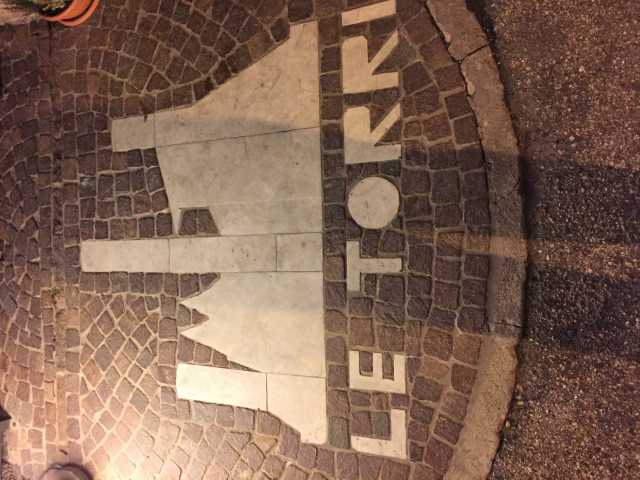Our visit to Paolo Scavino.
Six intrepid travelers set out from Castiglione delle Lanza, where we are staying at an Agrotourismo at Cascina Gallarin, a small winery, for a visit at Paolo Scavino in Castiglione Falletto. Thanks to GPS, we got very close, and after a few U-turns, we saw the sign on the side of the road. We were greeted by Ricardo, an enthusiastic young man who gladly showed us through the winery and then shared six bottles of wine with us.
What we learned:
They own all the vineyards they use and do not purchase grapes. Their vineyards are spread throughout the Barolo “appellation.” I do not remember exactly how many he said they had, but I think it was more than 20.
Their total production is about 11,000 cases. I had asked Mike Officer before we left how much wine Carlisle produced so I had something for comparison and he said 8500-10000 depending on various factors. So Scavino, which I viewed as a significant international Barolo producer, is just a bit bigger than Carlisle, which I view as a boutique specialty California producer that only those in the know get to taste.
They have been producing wine for almost 100 years and the fourth generation of the family is now involved. Their cellars include bins of unlabeled wines going back almost the full 100 years, plus a special room off to the side with a collection of 12 liter bottles that they have because they know they will last a very long time. It turns out that you can’t legally sell a 12 liter as “Barolo” but, of course, the family doesn’t care because they know what’s in the bottle and it’s for their personal consumption for special events.
Aging is in both large Slavonian oak barrels and assorted French barriques of varying ages. Mostly neutral oak.
What we tasted:
They had nothing to sell and Ricardo was very apologetic about how he did not have anything of the current release to pour for us because it was all gone out the door, but instead we got a sneak peek at the 2014s in unlabeled shiners, along with a treat older bottle for comparison and a bottle or two in the middle.
Sorriso Langhe (? Vintage) – a white blend of 40% Chardonnay, 40% Sauvignon Blanc and 20% Viognier. That’s right boys and girls, Viognier! Not a normal Piemonte grape. A very interesting and enjoyable white blend with a lot of complexity, a reasonable level of acidity, and delicious aromatics. A mixture of white fruit and tropical fruit with just a bit of citrus in the background. Winesearcher says available in New York for about $16. I never had this wine before, but I would be a buyer at that price.
Langhe Nebbiolo (2014) – Light and smooth without the complexity of the better single vineyards. It still had road tar/earthy and violet characteristics, but they were muted. Easy to drink young with lighter tannins. A nice entry level Nebbiolo for people hot used to the tannic bite of the better wines. We had learned earlier in the week that just because Nebbiolo is grown in the Barolo appellation, that does not necessarily mean that it can be marketed as Barolo. If it is grown on a north facing slope or on the valley floor, it cannot be called Barolo, so that is where these grapes are from. A few wineries also told us that they might declassify grapes that would qualify as Barolo if the quality was not satisfactory.
Barolo (2014) – The middle between the Langhe and the single vineyards. Has all the characteristics of a good Barolo but still a bit on the light side. Subdued violets on the nose. Red fruit and earth on the palate. Currently drinkable.
Barolo Bricco Ambrogio (2014 and 2003) – These were my favorites by far. I had never had this cru before. From Roddi, about 5 miles north of the winery. The floral nose of the 2014 was dramatic. Violets, roses and even a bit of lilac. The palate was soft, easy to drink, fruit driven with a mushroom and an herbal/forest floor component to it, but the strong floral nose continued to affect the palate in a very positive way. The 2003 was given to us blind. I guessed 2007 and was very surprised that it was a 2003, the extremely hot vintage that has generated some prune flavored wines from the region. There was none of that here. Although the nose was a bit more subdued, it was still a complex floral mix. The palate had developed a lot more complexity, especially in the earthy herbal and mushroom component. More classic road tar.
Barolo Cannubi (2014) – This was big and brawny. If the Ambrogio was smooth and feminine, this was powerful and masculine. Strong cherry component with a lot of earthiness. There was some violet on the nose. This vineyard is in the commune of Barolo itself. Very classic wine from a producer that maintains classic methods of production. This wine could last many decades and continue to grow in flavor, or so I would guess. Ricardo, however, pointed out, that you never know what the future will bring with wine.
We had a few other wines but my notes are not good enough to describe them.
Another important concept - when looking for a place for lunch, as the local guy. Ricardo directed us to a restaurant called Le Torri and then called to make us a reservation. It was quite an adventure driving a full sized van with three rows of seats up the hill around the curves and through the one lane street to the top of Serralunga d’Alba, but it was worth the trip. Outstanding veal cutlet with hazelnut crust and gnocchi with a pumpkin cream sauce.
